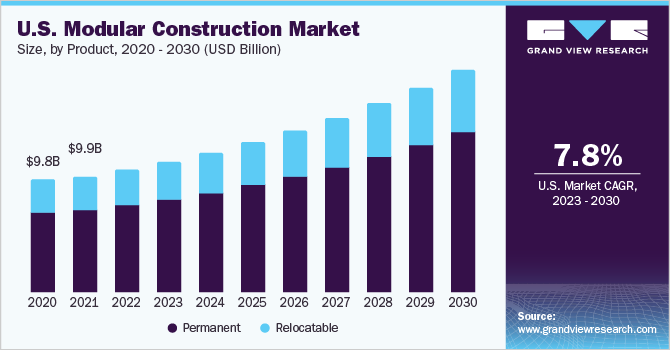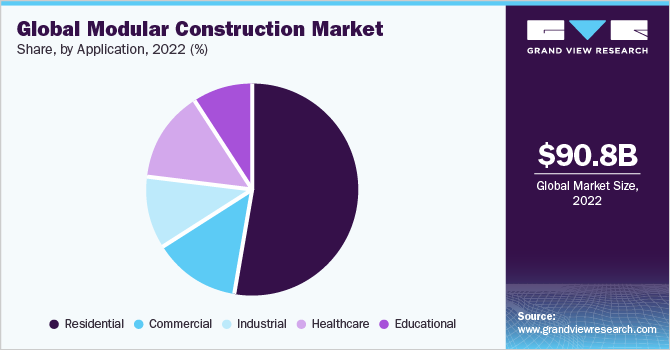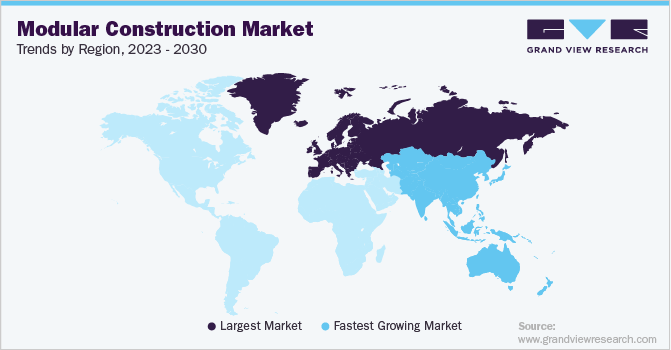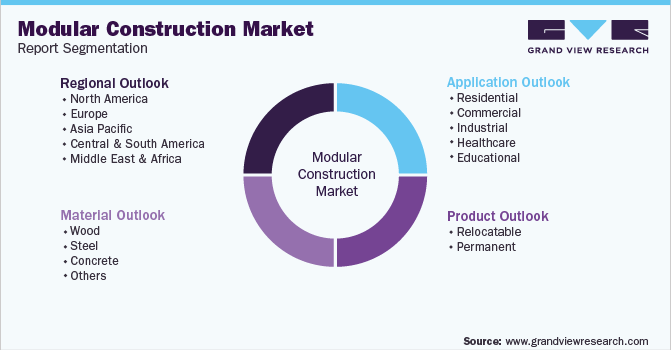- Home
- »
- Advanced Interior Materials
- »
-
Modular Construction Market Size & Share Report, 2030GVR Report cover
![Modular Construction Market Size, Share & Trends Report]()
Modular Construction Market Size, Share & Trends Analysis Report By Product (Relocatable, Permanent), By Material (Wood, Steel, Concrete, Others), By Application, By Region, And By Segment Forecasts, 2023 - 2030
- Report ID: GVR-3-68038-561-8
- Number of Pages: 109
- Format: Electronic (PDF)
- Historical Range: 2018 - 2021
- Industry: Advanced Materials
Report Overview
The global modular construction market size was estimated at USD 90.79 billion in 2022 and is expected to register a growth of 7.5% over the forecast period. This growth is attributed to the growing demand for affordable housing coupled with the increasing investment in the development of healthcare and commercial infrastructure around the globe. Off-site building activities in the urban regions are also growing, which is further driving the growth of modular construction market. Off-site building is not affected by weather conditions as they are manufactured within closed factories using advanced machinery, thereby, optimizing the construction time and providing high-quality products. The aforementioned benefits of off-site building make modular construction cost-effective and contribute to less site-generated waste.

Rapid urbanization and industrialization are expected to increase the number of new projects, primarily in the commercial and industrial sectors. This is likely to fuel the growth of the construction industry across the globe. Increasing technological advancements in building industry coupled with the advantages provided by modular construction such as reduced building schedule, reduced cost, greater flexibility, reuse, and less material waste are contributing to the product demand.
The U.S. market is expected to grow both in terms of the number of building units and revenue. Several multinational companies are investing in advanced modular construction technologies such as Building Information Modeling (BIM), artificial intelligence (AI), Internet of Things (IoT), 3D printing, and real-time data analytics for cost savings. Additionally, to provide multifamily residential structures, the U.S. government and companies are investing heavily in modular construction sector, thus boosting the market growth.
Modular construction enables the completion of a project in less than half of the time taken by traditional construction methods. In a time of crisis like the COVID-19 pandemic, time is invaluable in building new healthcare set-ups. Several countries are adopting and approving modular construction techniques for hospitals and treatment centers.
Modular construction enables industries to customize their designs and utilize the latest innovations in style and functionality. Before the development of modular construction, industries were compelled to spend countless man-hours on planning and designing, while actual construction took months or years to complete. Modular construction takes the guesswork out of the planning stages and simplifies building to a large extent, reducing the time from conception to completion by months or more.
Increasing efforts by the players to adopt the latest technologies such as 3D printing, building information modeling (BIM) for the optimizing their offsite module construction activities is likely to have a positive impact on the market growth. However, fluctuation in the transportation cost is anticipated to hamper the market growth over the projected period.
Product Insights
Based on product, the permanent modular construction segment dominated the market with the revenue of USD 58.21 billion in 2022. The segment is further expected to expand at a CAGR of 7.8% over the forecast period on account of offering high quality control in comparison to on-site construction.
Permanent modular construction (PMC) method is the innovative and sustainable construction method that facilitates off-site manufacturing of prefabricated modules that are deployed in single or multi-story buildings. Additionally, these modules can be integrated into an existing structure or can be built to stand independently.
Relocatable product segment is anticipated to grow at a CAGR of 7.0% for the peirod of 2023-2030 as temporary housings for emergency and relief operations that have gained popularity over the past decade. These buildings are made to be repurposed and transported to various building sites.
In the case of an immediate requirement for residential houses for a group of underprivileged people, relocatable construction models are the best alternative for managing time and economic constraints. Government initiatives and regulations toward sustainability and a green environment are also expected to fuel the market growth over the forecast period.
Material Insights
The steel segment has emerged as the largest market segment in 2022 with the revenue of USD 37.69 billion. It is used in various shapes like H-type beams, columns, angles, I- beam shapes, and T-shapes. The material exhibits excellent mechanical and chemical properties such as high strength, durability, ductility, ease of fabrication, seismic resistance, and fast erection speed. It is used as a reinforcing material in concrete to compensate for its low tensile strength.
Pre-engineered steel structural solutions are widely used in large open spaces, mostly for commercial or industrial uses. Steel frames are lighter in comparison to other wall materials, which allows building structures to be craned and transported in a more efficient manner, resulting in less disturbance to the local area and reduced costs. It is recyclable in nature and hence buildings made from steel can be easily dismantled. It is one of the most popular materials used in relocatable buildings that are used as commercial buildings, warehouses, and retail outlets.
Wood material segment is expected to grow at a CAGR of 7.4% over the period of 2023-2030. Mass timber can be used to substitute concrete and steel in construction to minimize greenhouse gas emissions without compromising on quality. Although mass timber is lighter than steel and concrete, it exhibits the same durability and seismic performance as these traditional construction materials.
Timber has emerged as a viable mass-scale alternative to traditional materials in the modular construction industry over the past decade. It is widely used in modular construction due to its excellent properties such as high durability, lightness, and low toxicity. It is biodegradable in nature and easy to reuse and recycle, which is further expected to increase its demand over the forecast period.
Application Insights
The residential segment accounted for the largest segment consist 52.7% of the total market in 2022 and is also expected to be the fastest growing segment by 2030. Modular construction can be used to construct attractive buildings that focus on sustainability, and aesthetics. It allows rapid building, feasibility in terms of challenging designs, and the building of unique and customizable homes that fulfill the requirements of communities.
The residential application segment includes single-family houses, multi-story residential buildings, and rental housing properties. Modular construction is witnessing rapid adoption in residential applications owing to its ability to significantly reduce building cost and time. The rising number of migrants necessitating the building of temporary and permanent housing structures in the world is expected to augment the demand for residential modular construction over the forecast period.

Commerical application segemnt in modular construction market was valued at the revenue of USD 11.95 billion in 2022 and is expected to reach USD 21.01 billion by 2030. In the past few years, the commercial modular construction market has gone mainstream. The recovering economic situations in key markets such as the U.K., the U.S., and Asia are expected to generate robust demand for commercial spaces such as offices, showrooms, and hotels, thus, leading to an increase in commercial building activities.
From portable commercial buildings to modular retail stores, modular construction holds the potential to disrupt the industry. These buildings are constructed in accordance with the International Building Code (IBC) or a version of a code modeled after the IBC and state regulations. The dynamism of modular construction makes it an ideal option for use across different commercial sectors such as offices, public restrooms & bathrooms, restaurants, and diners. It can also be used for long-term, temporary, or permanent facilities such as temporary retail buildings or offices.
Regional Insights
Europe was the largest market for modular construction in 2022 with the revenue of USD 41.29 billion, on account of the high level of penetration in Germany, Finland, the U.K., and Sweden. The primary driving factor is expected to be the rising influx of migrants necessitating the development of temporary and permanent housing structures. Moreover, factors such as multiple investments and the implementation of advanced technologies are driving the modular construction market in Europe.
In U.K., modular construction is gaining popularity as a viable method of constructing affordable homes owing to various factors such as population growth and shortages in housing. The number of modular homes in the country is increasing, and the country's top construction companies, investors, and developers are exploring modular housing solutions. As the UK government plans to construct approximately 300,000 new homes per year to address the challenges in the housing market, modular construction is expected to play a significant role.

Asia Pacific is expected to witness fastest growth with the CAGR of 8.3% over the forecast period. This is due to the rising international investments in the region's infrastructural sector supporting the market growth. The increasing demand for sustainable structures owing to growing environmental concerns and rising pollution rate is propelling the deployment of modular construction, in turn, contributing significantly to the product growth.
According to the Global Construction Survey, China's construction sector is anticipated to rise by 12.4%, reaching USD 1355.31 billion in 2021. Modular construction has gained traction in the country in the last two decades owing to the rapid economic development, rising labor costs, the quality & affordability of homes, innovations in technologies, and promotion of national policies.
Key Companies & Market Share Insights
Key players have adopted various growth strategies, such as acquisitions, mergers, contracts, and agreements, to increase their shares in the market and enhance their product and service portfolios. Additionally, they are focusing on energy efficiency and customization to fulfill specific customer requirements. Some prominent players in the global modular construction market include:
-
Sekisui House Ltd.
-
LAING O'ROURKE
-
Red Sea International
-
Skanska
-
Bouygues Construction
-
Premier Modular Limited
-
KLEUSBERG GmbH & Co KG
-
DuBox
-
Wernick Group
-
CIMC Modular Building Systems Holdings Co., Ltd. (CIMC-MBS)
-
Riko Hiše d.o.o
-
Lendlease Corporation
-
Modulaire Group
-
Guerdon, LLC
-
Hickory Group
Modular Construction Market Report Scope
Report Attribute
Details
Market size value in 2023
USD 96.77 billion
Revenue forecast in 2030
USD 162.40 billion
Growth Rate
CAGR of 7.5% from 2022 to 2030
Base year for estimation
2022
Historical data
2018 - 2021
Forecast period
2023 - 2030
Quantitative units
Revenue in USD billion, and CAGR from 2023 to 2030
Report coverage
Revenue forecast, competitive landscape, growth factors, and trends
Segments covered
Product, material, application, region
Regional scope
North America; Europe; Asia Pacific; Central & South America; Middle East & Africa
Country scope
U.S.; Canada; Mexico; U.K.; Germany; Sweden; China; India; Japan; Australia; Singapore; Brazil; Saudi Arabia; UAE
Key companies profiled
Sekisui House Ltd.; LAING O'ROURKE; Red Sea International; Skanska; Bouygues Construction; Premier Modular Limited; KLEUSBERG GmbH & Co KG; DuBox; Wernick Group; CIMC Modular Building Systems Holdings Co.; Ltd. (CIMC-MBS); Riko Hiše d.o.o; Lendlease Corporation; Modulaire Group; Guerdon; LLC; Hickory Group
Customization scope
Free report customization (equivalent up to 8 analysts working days) with purchase. Addition or alteration to country, regional & segment scope.
Pricing and purchase options
Avail customized purchase options to meet your exact research needs. Explore purchase options
Global Modular Construction Market Report Segmentation
This report forecasts revenue growth at global, regional & country levels and provides an analysis of the industry trends in each of the segments from 2018 to 2030. For this study, Grand View Research has segmented the modular construction market report based on product, material, application, and region:

-
Product Outlook (Revenue, USD Million; 2018 - 2030)
-
Relocatable
-
Permanent
-
-
Material Outlook (Revenue, USD Million; 2018 - 2030)
-
Wood
-
Steel
-
Concrete
-
Others
-
-
Application Outlook (Revenue, USD Million; 2018 - 2030)
-
Residential
-
Commercial
-
Industrial
-
Healthcare
-
Educational
-
-
Regional Outlook (Revenue, USD Million; 2018 - 2030)
-
North America
-
U.S.
-
Canada
-
Mexico
-
-
Europe
-
U.K.
-
Germany
-
Sweden
-
-
Asia Pacific
-
China
-
India
-
Japan
-
Singapore
-
Australia
-
-
Central & South America
-
Brazil
-
-
Middle East & Africa
-
Saudi Arabia
-
UAE
-
-
Frequently Asked Questions About This Report
b. The global modular construction market size was estimated at USD 90.79 billion in 2022 and is expected to reach USD 96.77 billion in 2023.
b. The global modular construction market is expected to grow at a compound annual growth rate a CAGR of 7.5% from 2023 to 2030 to reach USD 162.40 billion by 2030.
b. The permanent modular construction accounted for the largest revenue share in 2022 owing to the increasing adaption of modular construction techniques in commercial construction activities.
b. Some key players operating in the modular construction market include Sekisui House Ltd., LAING O'ROURKE, Red Sea International, Skanska, Bouygues Construction, Premier Modular Limited, KLEUSBERG GmbH & Co KG, DuBox, Wernick Group, CIMC Modular Building Systems Holdings Co., Ltd. (CIMC-MBS), Riko Hiše d.o.o, Lendlease Corporation, Modulaire Group, Guerdon, and LLC, Hickory Group.
b. The key factors that are driving the market growth is the growing off-site construction activities in countries coupled with increasing investment in the development of commercial infrastructure around the world.
Share this report with your colleague or friend.
![gvr icn]()
NEED A CUSTOM REPORT?
We can customize every report - free of charge - including purchasing stand-alone sections or country-level reports, as well as offer affordable discounts for start-ups & universities. Contact us now
![Certified Icon]()
We are GDPR and CCPA compliant! Your transaction & personal information is safe and secure. For more details, please read our privacy policy.
We are committed towards customer satisfaction, and quality service.
"The quality of research they have done for us has been excellent."





